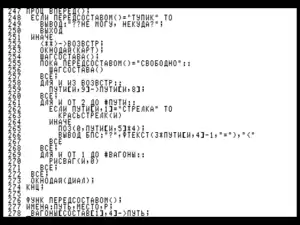Rapira
Rapira (Russian: Рапира, rapier) is an educational procedural programming language developed in the Soviet Union and implemented on the Agat computer, PDP-11 clones (Electronika, DVK, BK series), and Intel 8080 and Zilog Z80 clones (Korvet). It is interpreted with a dynamic type system and high level constructions. The language originally had a Russian-based set of reserved words (keywords), but English and Romanian were added later. It was considered more elegant and easier to use than Pascal implementations of the time.
- Rapira is also a name for the Soviet 100 mm anti-tank gun T-12
 Part of a Rapira program. | |
| Paradigms | procedural, structured |
|---|---|
| Designed by | Andrey Ershov |
| First appeared | 1982 |
| Typing discipline | dynamic |
| Scope | Lexical (static) |
| Platform | Agat, PDP-11 (clones: Electronika, DVK series); Intel 8080, Zilog Z80 |
| Influenced by | |
| ALGOL, POP-2, SETL | |
Rapira was used to teach computer programming in Soviet schools.[1] The integrated development environment included a text editor and a debugger.
Sample program:
ПРОЦ СТАРТ()
ВЫВОД: 'Привет, мир!!!'
КОН ПРОЦ
The same, but using the English lexics [sic, from the article referenced below]:
proc start()
output: 'Hello, world!!!';
end proc
Rapira's ideology was based on languages such as POP-2 and SETL, with strong influences from ALGOL.
Consequently, for example, Rapira implements a very strong, flexible, and interesting data structure, named a tuple. in Rapira, these are heterogeneous lists with allowed operations such as indexing, joining, length count, getting of sublist, easy comparison, etc.
References
- Tsikoza, Vitaly Arkadievich; Glagoleva, Natalia Georgievna; Nalimov, Evgeny Viktorovich; Zemtsov, Pavel Apolinarevich; Baraz, Leonid Semenovich; Borovikov, Yegor Vasilievich (10 August 1987). The Rapier Programming Language. Archive of Academician Andrey Ershov (Report). AP Ershov Institute of Informatics Systems, Siberian Branch of the Russian Academy of Sciences (ISI SB RAS). Retrieved 16 April 2021.
External links
- ReRap2 on GitHub, interpreter for English dialect of Rapira
- Rapira Reborn, instructional book for learning Rapira